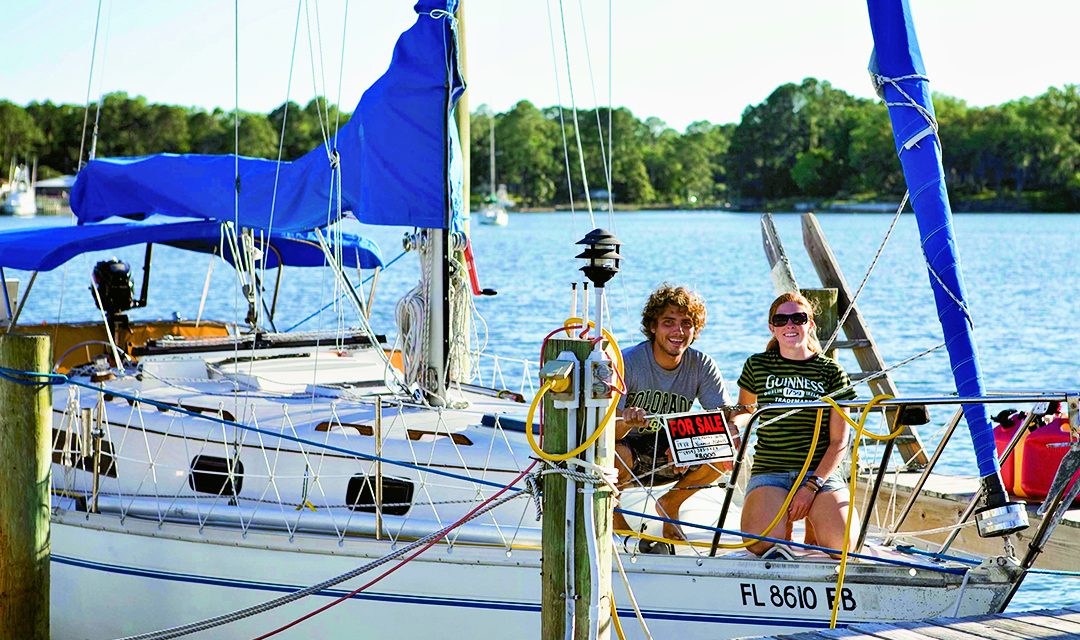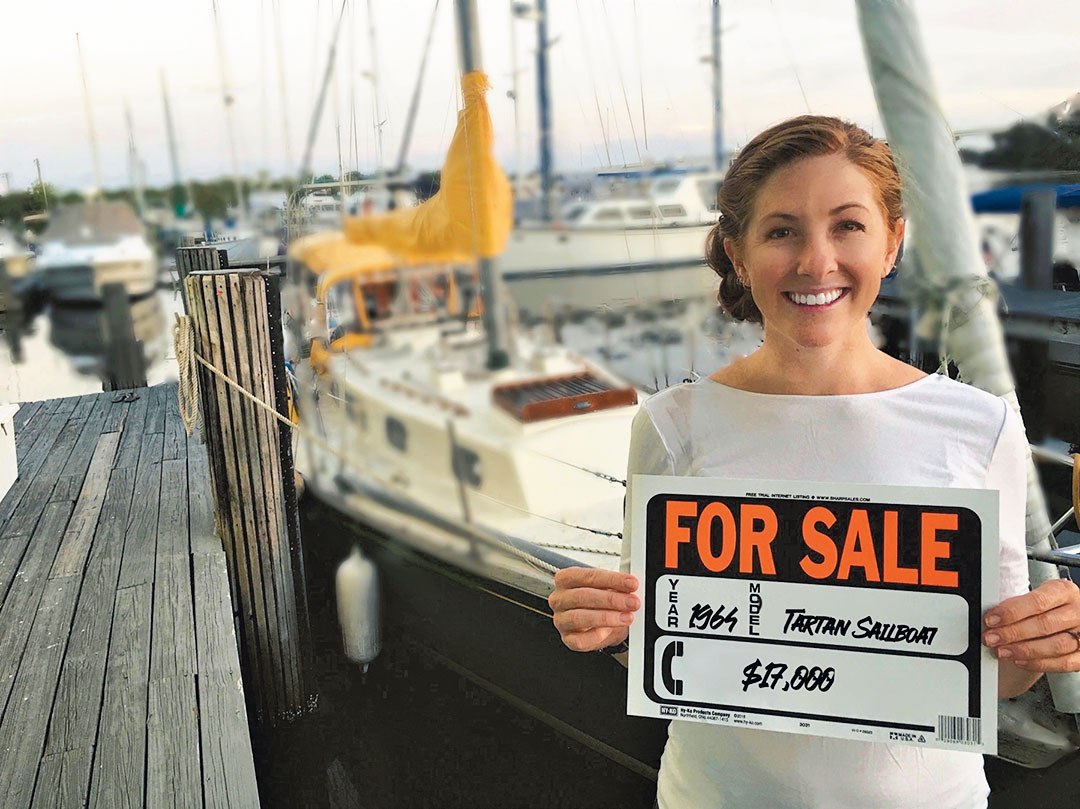Want to successfully sell your boat on your own? Here’s how.
Over the past decade, my husband and I have bought six sailboats and sold five of them (we live aboard the boat we bought most recently). In our experience, boat ownership is a transition. On the day we bought each of our boats, we loved the vessel more than our firstborn. When we’ve been ready to sell, we’ve wanted each boat gone faster than that same beloved 18-year-old heading off to college.
Unfortunately, selling a boat is rarely an overnight affair. Fortunately, we’ve gained enough experience to minimize the amount of time a boat sits on the market and to get a fair price.
We have always bought and sold in the lower price range, from $6,000 to $36,000. At these price points, using a broker hasn’t made sense for us. Brokers charge commissions, commonly 10 percent of the sale price with a $5,000 minimum. Selling on our own has proven a better option, and a successful one, because we stick to a strategy that we’ve honed.
Valuation
First, we price our boats to sell. People are often unrealistic about the value of their boat. It’s understandable. They know what they paid for their boat and they know the countless hours and dollars they’ve poured into it during the time they’ve owned it. In reality, all of the blood, sweat, and tears do not necessarily increase the value of the boat to others. Often, all that effort amounts to maintenance and repairs necessary to keep the boat up to standard. This is always a difficult truth to face.
The fact is, what you paid for your boat and what you spent on your boat during the time you owned it should not be how you determine your asking price when you put it up for sale.
Instead, focus on market research—and the more time you can give yourself to do this research, the more accurate your listing price will be. Three months has worked well for us.
Start by listing the defining characteristics of your vessel, such as fiberglass, cutter, wind vane, new sails, 35 feet, and new rigging. Then use these to search for boats similar to yours on the internet. Keep a list of these boats and their asking prices or bookmark them on your browser. Check back every week or so to see which come off the market. By the time you are ready to list your boat, you should have a comprehensive list of similar vessels that sold and did not sell in that three-month period. From this information, you’ll have a good start on determining a realistic asking price.
But don’t stop at evaluating price. There are three more things to consider: location, location, and location. Where are similar boats selling? Over the years, we’ve come to realize that 30- to 35-foot fiberglass boats usually sell best in Florida. Aluminum- and steel-hulled boats seem to do well in Canada and colder climates. Trimarans seem to sell equally well everywhere. Consider this location information as another input when considering prices. And if you’re able and willing to relocate your boat to a hot-selling area to get top dollar, this info is even more relevant.
One of the first boats we sold was a steel-hulled sailboat. We didn’t do any of our homework. The day we listed our boat, we looked online and found a similar vessel listed at $50,000. We listed ours for $40,000 to sell quickly. When someone mentioned Annapolis, Maryland, was a great place to sell, we sailed straight there. How did things go? Not well. Annapolis is a great market for high-end fiberglass production boats between 40 and 50 feet and filled with gadgets. The comparable vessel we’d used to set our price had been on the market for four years. We had a long wait, but when someone finally offered us $18,000, we couldn’t say yes fast enough!
Pricing is by far the trickiest step to selling a boat because it takes time and there are emotional hurdles to overcome, but rest assured the remaining steps are easier.
Presentation
Step two is creating a website where potential buyers can see photos, a description, and even a video of your boat. Using a website creator (see Resources sidebar), building a website is easy and fun—truth, it really is!—once you have all of your materials like photos and text gathered.
Start by drawing on all of your prideful feelings for your boat to create a list that highlights all of its best qualities. Then go to a website creator—I’ve had good success with wix.com, which is free—and make a website. This allows interested buyers to see all of the information for your boat in one location. It also lets you link to the site in all of your ads that otherwise only allow a short paragraph for a description and a few photos. With unlimited word count and photo galleries, your boat will truly shine.
To sell each of our boats, we’ve always made four-page websites comprising home page, a specifications page, a gallery page, and a contact page.
The photo of your boat in crystal-clear waters, sails up, rainbow in the background, dolphin at the bow? That belongs on the home page. This page is for selling the dream. You can also have a short paragraph beneath the photo, describing your best sail. You want interested buyers’ jaws to drop when that home page loads. You want them to turn to their partner and say, “Look, that could be us!”
The specifications page is where we get technical. We list all of the amenities and systems aboard, organized into sections, such as electronics, tankage, engine, and galley. We are careful to space the sections so they are easy to read. Be accurate and comprehensive on this page, for you and the buyer. You don’t want to get a call from someone whose interest you’ve piqued, only to hear their disappointment when they learn that all of your instrumentation is Raymarine and they want Garmin. It’s best they find that out on their own and you are never the wiser. We also like to include line drawings on this page that we grab from sailboatdata.com. This makes it clear what the boat’s hull looks like and how the interior is laid out.
The gallery page is the most important section of your website because this is where potential buyers can really see your boat. Photos must be crisp and show exterior, interior, and even details of specifics like the engine or electrical panel. And, they have to be recent. We have visited boats that weren’t even painted the same color depicted in the photos we saw in the ad. A buyer who drives hours to see your boat, only to discover it’s four years older than the photos, won’t be happy and probably won’t buy your boat.
Before taking photos, clear out your things and tidy up. Many boats we have looked at would have sold for thousands more had the owner taken the time to more thoughtfully prepare for the photo shoot. My husband and I have lived aboard boats we’ve listed for sale, and while it’s tempting to just clean up and snap a few photos, this is a mistake. Just as it’s true for real estate sales, it’s difficult for someone to picture themselves aboard a boat full of other people’s stuff. Get as many of your belongings as possible off the boat, even if temporarily, before shooting photos. And, think about what you’re showing. If the pan under your engine is half an inch deep in oily bilge gunk, mop it up before taking a photo.
Once you have cleaned and cleared, it’s picture time. I use a Canon Rebel T6i with a lens hood, but that’s overkill. A decent smartphone is capable of delivering professional-looking photos—but only if done right. Overcast days are perfect for taking interior photos. This is because the natural light casts an even glow over everything, rather than shadowy blobs and bright spots that might happen on a clear sunny day. If the lighting in your cabin is warm and your camera skills adequate, nighttime photos can render a cabin inviting.
Try to keep all of your shots oriented the same, either portrait or landscape; consistent orientation makes for a clean and crisp layout on a website. Don’t do a closeup unless it is meaningful. A closeup of a light fixture is not helpful, a closeup of the engine-hour meter is. Make sure to include the nitty-gritty; accessibility to things like the stuffing box and engine are as important as your galley layout. Consider what you’d want to see if you were boat shopping. Photograph as though you are giving a tour to a friend who cannot be there in person.
Take a ton of photos—and then take more. We’ve determined that there cannot be too many photos to satisfy interested buyers. We once listed a vessel with 120 photos, only to receive a request for more. In response, we added a video tour. I don’t think this is necessary in all cases, but it’s worth considering; any buyer who gets an actual walkthrough of your boat and then commits to seeing it in person is probably going to be a serious buyer.
Finally—and this may seem obvious but it’s still worth stating—don’t post out-of-focus images on your website. Choose only the sharpest, best lit, and well-composed images to show off your boat.
As soon as your website is created, share the address everywhere you can. Make listings on Craigslist in all the surrounding areas—buyers often are not deterred by a six-hour road trip to see the boat of their dreams. Although Yachtworld.com is restricted to broker listings only, Sailboatlistings.com caters to boat owners selling their own boats. We have found that boats we’ve listed on this site get plenty of traffic, perhaps more than the broker-only sites.
Is there a Facebook group for your specific model of boat? Share your listing there! Maybe there’s a Facebook group dedicated to sailing in your geographic area—post there. Is there an owner’s association with a forum you can list on? A bulletin board at your yacht club? Local chandlers? Consider that other people read the same sailing magazines you do—buy a classified ad. (Good Old Boat offers affordable classified ad rates and free online listings for subscribers.) The point is to share your website address far and wide.
A word here about transparency. When creating this website and selling the dream of owning your sailboat, you may be tempted to be a tad optimistic about the state of certain key components. Which brings me to one of the rules we follow when listing a boat. Be honest! If you have listed the boat at a reasonable price, there is no need to omit issues. In the right price range, people are expecting to put in a certain level of maintenance and elbow grease in order to get themselves off the dock. The more honest you are, the more comfortable everyone feels about the entire process. It makes for a smooth transition, and it continues the tradition of sailors being some of the most helpful and kind people out there.

Consummation
So, you came up with a price, created a website, and plastered the website address everywhere. If you hit the mark, at this time you should be getting more emails and phone calls than you know what to do with. Now is not the time to second-guess yourself and wonder if your listing price is too low. You’re receiving interest in your boat because you’ve priced it fairly and created a quality listing.
The next step is to make a spreadsheet and enter all of the names and phone numbers and last-contacted dates. It may seem like an unnecessary step, but when you have emails coming in from a website, Facebook, and forums, you’ll be glad you entered all the information into one cohesive place for reference. This keeps things organized and prevents anyone cutting in line, which keeps everyone happy.
It also ensures that you keep all offers correctly recorded. And now starts the wheeling and dealing. Because you have foregone a broker, this will require you and the potential buyer to agree on the next order of business. Usually, when dealing with a broker, these next steps are well out of your hands. This time, however, it is up to you. The perfect boat deal goes as follows:
- Buyer makes offer contingent on sea trial and survey.
- Seller takes offer with 10-percent non-refundable deposit.
- Buyer has sea trial with seller, and it goes smoothly.
- Buyer commissions survey and surveyor finds nothing.
- Seller drafts a bill of sale.
- Buyer and seller go to bank to get a notary.
- Buyer wires funds to seller’s account.
- Seller relinquishes all documents and keys.
- Both shake hands and walk away happy.
In our experience, it rarely works out exactly like that. There’s always some variation on this process. We’ve bought boats without a survey or a sea trial. (We looked at one boat and bought it that same afternoon. Everything worked out fine.) We’ve put the seller of a $6,000 boat through a 10-hour survey, two sea trials, and an agreement to let us stay at his dock for a month. Whatever variation makes all parties feel comfortable is the right variation.
That said, the transfer of funds and documents is the most stressful and potentially hazardous part of selling a boat on your own. Without a broker, there is no escrow account to safely transfer the money to while you sign the documents over to the new owner. This means there’s a moment when the boat or the money is transferred without reciprocity. Unfortunately, there is no easy answer to this other than using trust and heeding a few best practices.
Some people are unaware that they can draft contracts and bills of sale on their own. If you are worried that someone might back out of a deal or is just doing a sea trial for a free day sail, request a deposit early in the process. Require that all funds are transferred by wire, and never accept a cashier’s check—they can be canceled after documents are signed and your boat is gone. Your bank can call ahead to ensure the funds are in the buyer’s account prior to the wire transfer processing and becoming available in your account. A few small steps may help you to feel at ease during this process, but in the end, trust your gut.
We once listed a boat in Florida for $14,000 and then flew home to Alaska. While away, we got a call from an interested buyer. After chatting on the phone a few times and looking at the boat, she made a full-price offer contingent on a sea trial. I felt comfortable with her, so I was honest. We didn’t want to fly from Alaska to Florida for a sea trial, so I was willing to knock $1,000 off the selling price. She said yes. When it came time for surrendering ownership and transferring payment, we realized she would have to transfer a large deposit to me before even seeing the paperwork or meeting me in person. I would then have to sign over everything to her only having received half of the payment. Both of us felt comfortable doing this. I’d talked to her enough to get a sense of her and I felt I could trust her. Three days after she received the paperwork, we received the remaining balance. To this day, we’re in contact with this buyer.
In the end, the goal is to complete the sale in a timely manner with all interested parties walking away with ear-to-ear grins. Often, that’s exactly what we have experienced. And, having sold the boat ourselves, we’ve pocketed cash that would have gone to a broker, and we’re ready to start shopping for our next boat.






